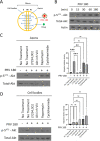A Pseudorabies Virus Serine/Threonine Kinase, US3, Promotes Retrograde Transport in Axons via Akt/mToRC1
- PMID: 34985995
- PMCID: PMC8906396
- DOI: 10.1128/JVI.01752-21
A Pseudorabies Virus Serine/Threonine Kinase, US3, Promotes Retrograde Transport in Axons via Akt/mToRC1
Abstract
Infection of peripheral axons by alpha herpesviruses (AHVs) is a critical stage in establishing a lifelong infection in the host. Upon entering the cytoplasm of axons, AHV nucleocapsids and associated inner-tegument proteins must engage the cellular retrograde transport machinery to promote the long-distance movement of virion components to the nucleus. The current model outlining this process is incomplete, and further investigation is required to discover all viral and cellular determinants involved as well as the temporality of the events. Using a modified trichamber system, we have discovered a novel role of the pseudorabies virus (PRV) serine/threonine kinase US3 in promoting efficient retrograde transport of nucleocapsids. We discovered that transporting nucleocapsids move at similar velocities in both the presence and absence of a functional US3 kinase; however, fewer nucleocapsids are moving when US3 is absent, and they move for shorter periods of time before stopping, suggesting that US3 is required for efficient nucleocapsid engagement with the retrograde transport machinery. This led to fewer nucleocapsids reaching the cell bodies to produce a productive infection 12 h later. Furthermore, US3 was responsible for the induction of local translation in axons as early as 1 h postinfection (hpi) through the stimulation of a phosphatidylinositol 3-kinase (PI3K)/Akt-mToRC1 pathway. These data describe a novel role for US3 in the induction of local translation in axons during AHV infection, a critical step in transport of nucleocapsids to the cell body. IMPORTANCE Neurons are highly polarized cells with axons that can reach centimeters in length. Communication between axons at the periphery and the distant cell body is a relatively slow process involving the active transport of chemical messengers. There is a need for axons to respond rapidly to extracellular stimuli. Translation of repressed mRNAs present within the axon occurs to enable rapid, localized responses independently of the cell body. AHVs have evolved a way to hijack local translation in the axons to promote their transport to the nucleus. We have determined the cellular mechanism and viral components involved in the induction of axonal translation. The US3 serine/threonine kinase of PRV activates Akt-mToRC1 signaling pathways early during infection to promote axonal translation. When US3 is not present, the number of moving nucleocapsids and their processivity are reduced, suggesting that US3 activity is required for efficient engagement of nucleocapsids with the retrograde transport machinery.
Keywords: Akt; PRV; US3; axon; intracellular transport; kinase; mToRC1; pseudorabies virus; retrograde transport; translation; viral entry.
Conflict of interest statement
The authors declare no conflict of interest.
We declare that we have no competing interests.
Figures








Similar articles
-
Herpes simplex virus protein kinases US3 and UL13 modulate VP11/12 phosphorylation, virion packaging, and phosphatidylinositol 3-kinase/Akt signaling activity.J Virol. 2014 Jul;88(13):7379-88. doi: 10.1128/JVI.00712-14. Epub 2014 Apr 16. J Virol. 2014. PMID: 24741093 Free PMC article.
-
Remodeling mTORC1 Responsiveness to Amino Acids by the Herpes Simplex Virus UL46 and Us3 Gene Products Supports Replication during Nutrient Insufficiency.J Virol. 2018 Nov 27;92(24):e01377-18. doi: 10.1128/JVI.01377-18. Print 2018 Dec 15. J Virol. 2018. PMID: 30282708 Free PMC article.
-
Subversion of Host Responses to Energy Insufficiency by Us3 Supports Herpes Simplex Virus 1 Replication during Stress.J Virol. 2017 Jun 26;91(14):e00295-17. doi: 10.1128/JVI.00295-17. Print 2017 Jul 15. J Virol. 2017. PMID: 28468873 Free PMC article.
-
CRISPR/Cas9-Constructed Pseudorabies Virus Mutants Reveal the Importance of UL13 in Alphaherpesvirus Escape from Genome Silencing.J Virol. 2021 Feb 24;95(6):e02286-20. doi: 10.1128/JVI.02286-20. Print 2021 Feb 24. J Virol. 2021. PMID: 33361431 Free PMC article.
-
Transport and egress of herpes simplex virus in neurons.Rev Med Virol. 2008 Jan-Feb;18(1):35-51. doi: 10.1002/rmv.560. Rev Med Virol. 2008. PMID: 17992661 Review.
Cited by
-
Pseudorabies Virus Regulates the Extracellular Translocation of Annexin A2 To Promote Its Proliferation.J Virol. 2023 Mar 30;97(3):e0154522. doi: 10.1128/jvi.01545-22. Epub 2023 Feb 14. J Virol. 2023. PMID: 36786600 Free PMC article.
-
Transcriptome and Proteome Analyses Revealed Differences in JEV-Infected PK-15 Cells in Response to Ferroptosis Agonists and Antagonists.Animals (Basel). 2024 Dec 5;14(23):3516. doi: 10.3390/ani14233516. Animals (Basel). 2024. PMID: 39682481 Free PMC article.
-
Phosphoproteomic landscape of pseudorabies virus infection reveals multiple potential antiviral targets.Microbiol Spectr. 2024 Jan 11;12(1):e0301023. doi: 10.1128/spectrum.03010-23. Epub 2023 Nov 22. Microbiol Spectr. 2024. PMID: 37991362 Free PMC article.
-
Distinct effects of glucocorticoid on pseudorabies virus infection in neuron-like and epithelial cells.J Virol. 2025 Feb 25;99(2):e0147224. doi: 10.1128/jvi.01472-24. Epub 2025 Jan 24. J Virol. 2025. PMID: 39853115 Free PMC article.
-
The host cells suppress the proliferation of pseudorabies virus by regulating the PI3K/Akt/mTOR pathway.Microbiol Spectr. 2024 Oct 22;12(12):e0135124. doi: 10.1128/spectrum.01351-24. Online ahead of print. Microbiol Spectr. 2024. PMID: 39436133 Free PMC article.

